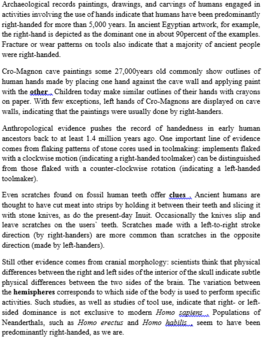Read the following passage and mark the letter A, B, C, or D on your answer sheet to indicate the correct answer to each of the questions from 36 to 42.
(1) Aging is the process of growing old. It occurs eventually in every living thing provided, of course, that an illness or accident does not kill it prematurely. The most familiar outward signs of aging may be seen in old people, such as the graying of the hair and the wrinkling of the skin. Signs of aging in a pet dog or cat include loss of playfulness and energy, a decline in hearing and eyesight, or even a slight graying of the coat. Plants age too, but the signs are much harder to detect.
(2) Most body parts grow bigger and stronger, and function more efficiently during childhood. They reach their peak at the time of maturity, or early adulthood. After that, they begin to decline. Bones, for example, gradually become lighter and more brittle. In the aged, the joints between the bones also become rigid and more inflexible. This can make moving very painful.
(3) All the major organs of the body show signs of aging. The brain, for example, works less efficiently, and even gets smaller in size. Thinking processes of all sorts are slowed down. Old people often have trouble in remembering recent events.
(4) One of the most serious changes of old age occurs in the arteries, the blood vessels that lead from the heart. They become thickened and constricted, allowing less blood to flow to the rest of body. This condition accounts, directly or indirectly, for many of the diseases of the aged. It may, for example, result in heart attack.
(5) Aging is not a uniform process. Different parts of the body wear out at different rates. There are great differences among people in their rate of aging. Even the cells of the body differ in the way they age. The majority of cells are capable of reproducing themselves many times during the course of a lifetime. Nerve cells and muscle fibers can never be replaced once they wear out.
(6) Gerontologists - scientists who study the process of aging - believe this wearing out of the body is controlled by a built-in biological time-clock. They are trying to discover how this clock works so that they can slow down the process. This could give man a longer life and a great number of productive years.
According to the passage, which of the following is NOT true?
A. All living things grow old.
B. Aging is unavoidable in any living things.
C. Plants show less signs of aging than any other living things.
D. Most body parts wear out during the course of a lifetime.






Đáp án C
- “Aging is the process of growing old. It occurs eventually in every living thing provided…” (Câu đầu đoạn 1) -> A, B đúng
- “Plants age too, but the signs are much harder to detect.” (câu cuối đoạn 1) -> “Cây cối cũng lão hóa, nhưng dấu hiệu khó nhận ra hơn.” không phải “ít có các dấu hiệu lão hóa hơn”, => C sai
- “Different parts of the body wear out at different rates.” (câu 2 đoạn 5) -> D đúng